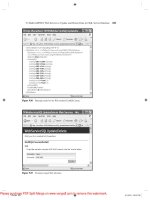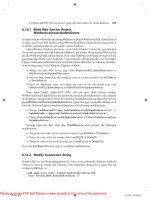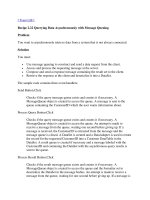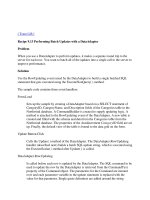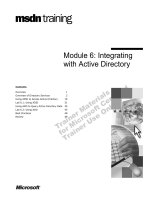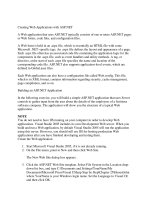Tài liệu Developing Secure Applications with Visual Basic doc
Bạn đang xem bản rút gọn của tài liệu. Xem và tải ngay bản đầy đủ của tài liệu tại đây (7.85 MB, 606 trang )
www.it-ebooks.info
Davis Chapman
800 East 96th St., Indianapolis, Indiana, 46240 USA
Developing Secure Applications
with Visual Basic
®
00 8369 FM 4/25/00 9:04 AM Page i
www.it-ebooks.info
Developing Secure Applications
with Visual Basic
Copyright © 2000 by Sams Publishing
All rights reserved. No part of this book shall be reproduced, stored in a
retrieval system, or transmitted by any means, electronic, mechanical, photo-
copying, recording, or otherwise, without written permission from the pub-
lisher. No patent liability is assumed with respect to the use of the information
contained herein. Although every precaution has been taken in the preparation
of this book, the publisher and author assume no responsibility for errors or
omissions. Nor is any liability assumed for damages resulting from the use of
the information contained herein.
International Standard Book Number: 0-672-31836-9
Library of Congress Catalog Card Number: 99-66271
Printed in the United States of America
First Printing: May 2000
02 01 00 4 3 2 1
Trademarks
All terms mentioned in this book that are known to be trademarks or service
marks have been appropriately capitalized. Sams Publishing cannot attest to
the accuracy of this information. Use of a term in this book should not be
regarded as affecting the validity of any trademark or service mark.
Warning and Disclaimer
Every effort has been made to make this book as complete and as accurate as
possible, but no warranty or fitness is implied. The information provided is on
an “as is” basis. The author and the publisher shall have neither liability nor
responsibility to any person or entity with respect to any loss or damages aris-
ing from the information contained in this book or programs accompanying it.
ASSOCIATE PUBLISHER
Bradley L. Jones
EXECUTIVE EDITOR
Chris Webb
DEVELOPMENT EDITOR
Steve Rowe
MANAGING EDITOR
Charlotte Clapp
PROJECT EDITOR
Carol L. Bowers
COPY EDITORS
Barbara Hacha
Chuck Hutchinson
INDEXER
Kevin Fulcher
PROOFREADER
Jill Mazurczyk
TECHNICAL EDITOR
John Hooven
TEAM COORDINATOR
Meggo Barthlow
MEDIA DEVELOPER
Jason Haines
INTERIOR DESIGNER
Anne Jones
COVER DESIGNER
Anne Jones
COPY WRITER
Eric Bogert
00 8369 FM 4/25/00 9:04 AM Page ii
www.it-ebooks.info
Contents at a Glance
Introduction 1
1 Understanding Encryption and Application Security 5
2 Getting Started with the CryptoAPI 19
3 Symmetric and Password Encryption 37
4 Public/Private Key Communications 93
5 Requesting and Retrieving Certificates 139
6 Working with Certificates 175
7 Working With Certificate Revocation Lists 217
8 Using Digital Signatures 257
9 DCOM Through SSL 309
10 Understanding Windows 2000 Security and Security Descriptors 339
11 Using NT Login Authentication 385
12 Working with Active Directory Security (ADSI) and an LDAP Server 407
13 Active Directory Security and Searching 441
14 Developing with COM+ Security 475
15 Microsoft Certificate Server 495
16 Security Standards 505
17 Legal Issues of Digital Signatures and Encryption 517
A Cryptographic Service Providers 529
Index 535
00 8369 FM 4/25/00 9:04 AM Page iii
www.it-ebooks.info
Contents
Introduction 1
1 Understanding Encryption and Application Security 5
Exploring Encryption 6
Encryption Algorithms and Standards 6
Other Forms of Encryption 10
Using Certificates with Encryption 13
Certificate Authorities 14
Certificate Chains 14
Digital Signatures 14
Message Enveloping 15
Secure Sockets Layer (SSL) 16
Security and Audit Logs 16
Why Do You Need Audit Logs? 17
What Information Needs to Be Included? 17
Summary 18
2 Getting Started with the CryptoAPI 19
CryptoAPI and Cryptographic Service Providers 20
Opening the CSP 21
Closing the CSP 25
Listing the Available CSPs 26
Listing the CSP Types 27
Getting the Default CSP 28
Setting the Default CSP 28
CSP Types and Encryption Algorithms 29
Listing CSPs and CSP Types 30
Designing the Interface 30
Listing the CSPs 32
Building a List of the CSP Types 34
Summary 36
3 Symmetric and Password Encryption 37
Generating Hashes of Strings and Messages 38
Creating a Hash Object 38
Destroying a Hash Object 40
Duplicating a Hash Object 41
Hashing Data 42
Hashing a Session Key 42
Getting Hash Information 43
Setting Hash Information 45
00 8369 FM 4/25/00 9:04 AM Page iv
www.it-ebooks.info
Generating Symmetric Keys 46
Deriving a Key 47
Generating a Key 48
Destroying a Key 50
Duplicating a Key 51
Understanding Basic Encryption and Decryption 52
Encrypting Data 53
Decrypting Data 54
Building a Simple Encryption Application 55
Declaring API Functions, Constants, and Variables 55
Exposing Properties 60
Acquiring a Handle for the CSP 61
Deriving a Password-Based Key 64
Destroying a Password-Based Key 66
Performing Data Encryption 67
Performing Data Decryption 69
Designing the User Interface 70
Performing the Encryption 71
Performing the Decryption 74
Building a File Encryption/Decryption Utility 77
Making Additional Declarations 77
Hashing the Data File 78
Encrypting the Data File 80
Decrypting the Data File 81
Designing the User Interface 83
Performing the Data File Encryption 85
Performing the Data File Decryption 89
Summary 92
4 Public/Private Key Communications 93
Block Versus Stream Algorithms 94
Salt Values: What Are They and Why Use Them? 95
Generating Salt Values 96
Extracting Salt Values from Session Keys 97
Setting Salt Values in Session Keys 100
Generating, Saving, and Retrieving Public/Private Keys 103
Exporting and Importing Keys 104
Exporting Keys 104
Importing Keys 107
Building a Secure Messaging Utility 108
Creating the Initial Project 108
Making Additional Declarations 109
Adding New Properties 110
00 8369 FM 4/25/00 9:04 AM Page v
www.it-ebooks.info
DEVELOPING SECURE APPLICATIONS WITH VISUAL BASIC
Getting the User Public/Private Key Pair 111
Exporting the Public Key 113
Importing the Public Key 114
Creating and Exporting the Session Key 115
Importing the Session Key 117
Terminating the Class 118
Designing the User Interface 119
Performing Form Initialization, Cleanup,
and Other Miscellaneous Functions 121
Performing the Initial Server Key Exchange 123
Performing the Client Key Exchange 125
Finishing the Server Key Exchange 126
Sending and Receiving Encrypted Messages 127
Listening for Connection Requests 130
Connecting to the Server 131
Receiving the Connection Request 132
Handling Data Arrival 133
Closing the Socket Connection 135
Summary 138
5 Requesting and Retrieving Certificates 139
Digital Certificates Explained 140
Requesting a Certificate from a Certificate Authority 141
Verifying the Key Owner’s Identity 142
Acquiring Certificates 143
Generating a Certificate Request 143
Retrieving Certificates 151
Building a Certificate Request Utility 155
Creating the Certificate Request Class 156
Creating the Class Properties 159
Class Initialization and Termination 161
Requesting Certificates 162
Retrieving Certificates 164
Checking on Request Status 165
Designing the Form 166
Form Initialization and Shutdown 168
Performing the Certificate Request 169
Checking the Status and Getting the Certificate 171
Running the Sample Application 171
Summary 173
vi
DEVELOPING SECURE APPLICATIONS WITH VISUAL BASIC
00 8369 FM 4/25/00 9:04 AM Page vi
www.it-ebooks.info
CONTENTS
6 Working with Certificates 175
Managing Certificate Stores 176
Opening Certificate Stores 177
Closing Certificate Stores 178
Duplicating the Store Handle 179
Managing Certificates and Certificate Contexts 179
Creating a Certificate Context 179
Duplicating a Certificate Context 180
Finding a Certificate 180
Enumerating Certificates 183
Getting an Issuer Certificate 183
Serializing a Certificate 184
Verifying a Certificate 186
Deleting a Certificate 186
Freeing a Certificate Context 187
Getting Information from Certificates 187
Enumerating Certificate Properties 188
Getting Property Values 189
Setting Certificate Properties 192
Getting the Subject Name 193
Building a Certificate Maintenance Utility 195
Creating the Project 195
Listing the Certificates 198
Converting Strings 207
Extracting the Key Spec 208
Extracting the Provider Type 209
Extracting the Container Name 210
Extracting the CSP Name 211
Designing the Form 212
Listing the Certificates 214
Summary 214
7 Working with Certificate Revocation Lists 217
Verifying Certificates Against a CA 218
Extracting a Certificate Serial Number 219
Formatting the Serial Number 222
The
CertAdmin COM Object 223
Verifying a Certificate 223
Building and Maintaining a Certificate Revocation List 226
Creating a CRL Context 226
Adding a CRL to a Certificate Store 227
Duplicating a CRL 229
Freeing a CRL Context 229
vii
CONTENTS
00 8369 FM 4/25/00 9:04 AM Page vii
www.it-ebooks.info
DEVELOPING SECURE APPLICATIONS WITH VISUAL BASIC
viii
Deleting a CRL 229
Getting a CRL from a Certificate Store 230
Verifying Certificates Against a CRL 231
Managing a Certificate Revocation List 233
Creating the Project 233
Adding New Properties 237
Converting Bytes to Hex String 238
Checking Certificates Against the CA 239
Creating a CRL from a File 241
Checking Certificates Against a CRL 243
Adding a CRL to a Certificate Store 244
Modifying the Certificate Listing 246
Modifying the Form 249
Using the CA to Verify Certificates 251
Using the CRL to Verify Certificates 252
Importing the CRL to the Certificate Store 254
Summary 255
8 Using Digital Signatures 257
What Are Digital Signatures? 259
Signing Messages and Verifying Signatures 261
Encryption Algorithms and Pointers 261
Signing a Message 262
Verifying a Message Signature 266
Verifying a Detached Message Signature 269
Determining the Number of Signers 270
Enveloping Messages 270
Encrypting a Message 270
Decrypting a Message 273
Signing and Encrypting a Message 275
Decrypting and Verifying a Message 276
Decoding a Message 277
Building a Signing Utility 279
Creating the Project 279
Retrieving the Signing Certificate 282
Determining the Certificate Type 284
Signing the Message 286
Verifying the Signature 289
Retrieving the Exchange Certificate 291
Encrypting the Message 293
Decrypting the Message 296
Releasing the Signature Certificate 299
Designing the Form 300
Getting the Signer Certificate 302
00 8369 FM 4/25/00 9:04 AM Page viii
www.it-ebooks.info
CONTENTS
ix
Performing the Signing 302
Performing the Signature Verification 304
Performing the Encryption 305
Performing the Decryption 307
Summary 308
9 DCOM Through SSL 309
RDS and HTTP 310
Standard DCOM Versus RDS DCOM 310
RDS
DataSpace Object 313
RDSServer DataFactory Object 313
RDS
DataControl Object 314
Interacting with Custom Server Controls 314
Enabling RDS Use 315
DCOM Tunneling Through TCP/IP 316
Client Configuration 317
Server Configuration for DCOM 319
Building a DCOM-HTTPS Application 323
Creating the Server Object 323
Creating the Client Application 329
Summary 337
10 Understanding Windows 2000 Security and Security
Descriptors 339
Windows 2000 Security Overview 340
Fundamental Security Data Structures 341
Understanding Process and Thread Security Tokens 341
Understanding the Security Identifier 346
Understanding
ACE, DACL, and SACL Structures 354
Determining the Size Required for an
ACL 355
Adding an Access-Allowed
ACE to a DACL 357
Security Descriptors 360
Retrieving a Security Descriptor 366
Using the
Security_Attributes Structure 369
Trustee-Based Access Control 370
Using the
TRUSTEE Structure 371
The
EXPLICIT_ACCESS Structure 375
Using
SetEntriesInAcl to Create and Modify Access Control
Lists 379
Impersonating a Client 381
Summary 383
00 8369 FM 4/25/00 9:04 AM Page ix
www.it-ebooks.info
DEVELOPING SECURE APPLICATIONS WITH VISUAL BASIC
x
11 Using NT Login Authentication 385
Validating a Domain Login 386
Modifying Access Permissions 386
Checking a Login Against a Domain 389
Granting Account Permissions 398
Granting Permissions on NT 4.0 398
Granting Permissions on Windows 2000 400
Building a Login Validation Utility 402
Creating the DLLs 402
Creating the User Interface 403
Checking the User Logon 405
Summary 406
12 Working with Active Directory Security (ADSI)
and an LDAP Server 407
Active Directory and Security 408
Opening an ADSI Session 408
The
IADs Object Interface 412
The
IADsContainer Object Interface 414
The
IADsNamespaces Object Interface 416
ADSI Security and Authentication 417
Active Directory Object Schemas 420
The
IADsClass Object Interface 420
The
IADsProperty Object Interface 421
The
IADsSyntax Object Interface 422
Network Groups and Users 423
The
IADsCollection Object Interface 423
The
IADsDomain Object Interface 424
The
IADsGroup Object Interface 425
The
IADsMembers Object Interface 427
The
IADsUser Object Interface 427
The
IADsComputer Object Interface 430
The
IADsFileShare Object Interface 431
Examining Groups and Users 432
Designing the User Interface 432
Listing the Groups 433
Listing the Group Members 434
Listing the Users 436
Listing the User Memberships 437
Calling the List Methods 438
Summary 439
00 8369 FM 4/25/00 9:04 AM Page x
www.it-ebooks.info
CONTENTS
13 Active Directory Security and Searching 441
Active Directory Object Security 442
The
IADsSecurityDescriptor Object Interface 443
The
IADsAccessControlList Object Interface 443
The
IADsAccessControlEntry Object Interface 444
Searching Active Directory 448
LDAP Scope Syntax 448
Building the SQL Syntax 448
Performing SQL Queries 449
Examining Active Directory Objects 450
Starting the Project 450
Traversing the Active Directory Tree 453
Examining Users and Groups 457
Examining Collections 460
Examining Miscellaneous Objects 462
Examining Object Security 464
Looking Up Object Details 471
Summary 473
14 Developing with COM+ Security 475
What Is COM+? 476
COM+’s Ancestry: COM/DCOM 476
Creating a COM Component in VB 478
Using a COM Component in VB 479
COM/DCOM in Perspective 483
Introducing Microsoft Transaction Server 485
COM+ and Security 488
Introducing MTS/COM+ Security 488
Declarative Security in COM+ 489
Building Security-Aware COM+ Components 492
Summary 494
15 Microsoft Certificate Server 495
How Certificate Authorities Work 496
Certificate Authority Hierarchies 496
Requesting and Issuing Certificates 497
Generating a Root Certificate 498
Issuing, Managing, and Revoking Certificates 500
Issuing and Denying Certificates 501
Revoking Certificates 501
Summary 503
xi
00 8369 FM 4/25/00 9:04 AM Page xi
www.it-ebooks.info
16 Security Standards 505
C2 Security 506
DES and RSA 507
DES 508
RSA 508
PGP and Kerberos 509
PGP 510
Kerberos 510
Smart Cards and Tokens 511
Emerging Technologies and Standards 512
Point-to-Point Tunneling 513
The PCT Specification 514
Summary 515
17 Legal Issues of Digital Signatures and Encryption 517
The Legal Implications of Digital Signatures:
Is a Digital Signature a Legal Signature? 518
When You Want to Use a Legal Signature 519
Recording Intent 519
Recording the Form of the Transaction 519
Using Digital Certificates with Your Application 521
Certificates Issued by an Internal Certifcate Server 521
Certificates Issued by a Public CA 521
Certificate Issued by a Public Authentication Service Provider 522
Certificate Formats 523
Single-Purpose Versus Multipurpose Certificates 523
First Modules—Choosing the Right One 524
Encryption and Export Issues 525
Strong Versus Export-Grade Encryption 525
Enabling Strong Encryption on Your Windows Clients 526
Complying with Export Regulations 526
Summary 527
A Cryptographic Service Providers 529
Index 535
00 8369 FM 4/25/00 9:04 AM Page xii
www.it-ebooks.info
About the Author
Davis Chapman first began programming computers while working on his Masters Degree in
Music Composition. While writing applications for computer music, he discovered that he
enjoyed designing and developing computer software. It wasn’t long before he came to the
realization that he stood a much better chance of eating if he stuck with his new-found skill
and demoted his hard-earned status as a “starving artist” to a part-time hobby. Since that time,
Davis has focused on the art of software design and development, with a strong emphasis on
the practical application of Client/Server and Web/Internet technologies. Davis was the lead
author for Sams Teach Yourself Visual C++ 6 in 21 Days, Web Development with Visual Basic
5, and Building Internet Applications with Delphi 2. Davis was also a contributing author on
MFC Programming with Visual C++ 6 Unleashed, Special Edition Using Active Server Pages,
and Running a Perfect Web Site, Second Edition. He has been a consultant working and living
in Dallas, Texas, for the past 10 years, and is currently with Rare Medium, an award-winning
Web site and Web application design firm. Davis can be reached at
00 8369 FM 4/25/00 9:04 AM Page xiii
www.it-ebooks.info
Dedication
As always, this is dedicated to my beautiful wife, Dore. I promise that next year I’ll have the time to
spend with you during the holidays, Valentines Day, your birthday…
Acknowledgments
Numerous people deserve a big thank you for all their help and support during the writing of
this book. First, my wife, Dore, deserves a great big hug for allowing me to take the time nec-
essary to write this book. It’s been a long, difficult task to get this one finished. I also need to
thank Chris Webb for carrying on within Macmillan, insisting that I was the one they needed to
write this book. I also need to thank Chris, Steve Rowe, and the rest of the editorial team for
putting up with me with a lot of patience and understanding through this project. John Hooven
deserves special credit for doing a great job as a technical editor. He made sure and pointed out
to me when I wasn’t doing something in quite as pure a Visual Basic way as I could have, and
he also let me know when I tried to get a little too fancy for my own good. I need to extend a
big thank you to Loren, Pierre, and Bill for pitching in and helping me finish writing this book,
and to Mickey for letting me adapt what he had written. I also have to thank John Banes at
Microsoft for taking the time to answer my questions. Finally, I’d like to thank everyone at
Rare Medium for providing me with a very enjoyable day job, and also for keeping me so busy
that it added at least a couple of months onto the time it took for me to write this book. Last
but not least, I’d like to thank you, the reader, for buying the books I write, so that Macmillan
continues to allow me to write books on topics such as this. Thank you!
00 8369 FM 4/25/00 9:04 AM Page xiv
www.it-ebooks.info
Tell Us What You Think!
As the reader of this book, you are our most important critic and commentator. We value your
opinion and want to know what we’re doing right, what we could do better, what areas you’d
like to see us publish in, and any other words of wisdom you’re willing to pass our way.
I welcome your comments. You can fax, email, or write me directly to let me know what you
did or didn’t like about this book—as well as what we can do to make our books stronger.
Please note that I cannot help you with technical problems related to the topic of this book, and
that due to the high volume of mail I receive, I might not be able to reply to every message.
When you write, please be sure to include this book’s title and author as well as your name
and phone or fax number. I will carefully review your comments and share them with the
author and editors who worked on the book.
Fax: 317-581-4770
E-mail:
Mail: Bradley L. Jones
Publisher
Sams Publishing
201 West 103rd Street
Indianapolis, IN 46290 USA
00 8369 FM 4/25/00 9:04 AM Page xv
www.it-ebooks.info
00 8369 FM 4/25/00 9:04 AM Page xvi
www.it-ebooks.info
Introduction
I know what you’re thinking. You saw this book on the shelf and picked it up out of curiosity,
thinking, “Encryption and Visual Basic? Security and Visual Basic? Aren’t these topics normally
reserved for the ranks of C/C++ developers?” Well, they used to be, but not anymore. Now you
can perform these tasks within Visual Basic, without having to dip into any C/C++ code.
The next question on your mind probably is, “Do I have to be a super mathematician to do this?
Doesn’t encryption require you to do some heavy calculations?” The answers to these questions
are, respectively, no and yes. Encryption does require some complex and heavy mathematical
calculations, but you don’t have to worry about those. You can continue to code your regular
Visual Basic code, with a few new twists to add in some very advanced functionality.
Thanks to Microsoft, all the topics covered in this book are built in to the latest versions of its
Windows and NT operating systems. This book shows you how to tap into these capabilities,
enabling you to include this functionality in your applications. In short, you’ll be letting the
operating system do all the work for you.
However, just because the operating system is doing all the heavy lifting, it doesn’t mean that
you get out of all the work. You still need to write some code to control this functionality.
Some of the code that you’ll need to write may stretch your Visual Basic skills beyond what
you’ve seen in most other programming situations. You’ll also have to delve into areas of pro-
gramming that Visual Basic normally tries to hide from you.
Take fair warning! This book is not for the Visual Basic beginner. If you just picked up Visual
Basic for the first time last week, this is not the book for you (yet). This book is written with
the assumption that you already know your way around Visual Basic and already have a bit of
Visual Basic programming experience under your belt. However, if you’ve built several appli-
cations using Visual Basic and you pretty much know all the basics, you shouldn’t have any-
thing to fear.
How This Book Is Organized
I wrote this book to match the way that I read technical books. If you’re like me, you aren’t
likely to read this book by starting on page 1 and reading straight through to the last page (not
that anything is wrong with doing that). When I read a book like this, I skip around, reading
just the chapters and sections that cover the specific topic that I want to learn. As a result, I’m
as likely to start with Chapter 12 before I read Chapter 1. I’m also likely to read only one or
two chapters to learn what I need right now, and then come back to this book several weeks or
months later to read another couple of chapters on the next topic that I need to learn.
01 8369 Intro 4/25/00 9:04 AM Page 1
www.it-ebooks.info
DEVELOPING SECURE APPLICATIONS WITH VISUAL BASIC
Therefore, this book is designed to be read in two ways. As is normal, this book is written and
organized to be read from page 1 to the end. It is also designed for the skip-and-jump style
reader, who reads only the chapters that cover what he or she needs to learn. Whenever a chap-
ter covers a topic that requires you to have some knowledge that is found in a previous chapter,
the topics are listed in a “Prerequisites” area. This enables you to glance over the background
information that you need before reading a particular chapter, so that you can make the deci-
sion on whether you are ready to tackle that chapter or whether you need to back up and read
an earlier chapter or two first.
This book is also organized around topic areas. The first portion of the book is concerned with
encryption. The second portion of the book focuses on security programming. The third por-
tion of the book covers some nonprogramming topics that you might need to be familiar with.
System Requirements
The ideal system for you to use for trying out the code in this book is a brand-new computer
running Windows 2000 and Visual Basic 6 (with maximum memory and disk space, surround
sound, DVD video, and so on. After all, I am talking about the ideal system). You also need to
have ready access to a computer running Windows 2000 Server, with Certificate Services
(Certificate Server) installed. You also should have access to the Administrator account on both
of those computers.
Now, to reenter the real world, the preceding requirements are not realistic for all interested
programmers. They are also not necessary for everything covered in this book. In reality, there
are a variety of requirements for the different topics covered within these pages.
For most of the encryption topics, you’ll need a base system of Windows 95 with Microsoft
Internet Explorer 3.02 (or later) installed. It is preferable that you have at least Internet Explorer 4
installed. Some specific functions exist that require Windows 98 or Windows 2000, and some are
available only on Windows 2000.
For the chapters dealing with certificates, you’ll need access to a Certificate Authority (you can
use Verisign, but unless you want to fork out some money, you may be limited to a temporary
certificate). The ideal situation is to have Microsoft’s Certificate Server installed on a nearby
machine. Some of the COM objects used for interacting with the Certificate Authority are avail-
able only with the Windows 2000 version of Certificate Server. Microsoft’s Certificate Server is
available only on the Server (or later) versions of NT 4.0 and Windows 2000. You won’t find it
on NT 4.0 Workstation or Windows 2000 Professional.
For the section dealing with security, you need to work with NT 4.0 or Windows 2000. For a
couple of the chapters in this section, you’ll be limited to working with Windows 2000.
2
01 8369 Intro 4/25/00 9:04 AM Page 2
www.it-ebooks.info
INTRODUCTION
Conventions Used
Several conventions are used in this book. Some of these are illustrated here.
3
Syntax
Function declarations are presented in a very bland-looking type (my
editor wants me to describe it as a “computer type”). This distinguishes
them from the surrounding text. After all, I wouldn’t want you to miss
something as important as function and type declarations by making them
blend into the rest of the page.
Listing 00.1 THE FOLLOWING CODE ISALISTING
Actual code listings look very similar to the function and type
declarations. One difference is that code listings are preceded by a
listing number and a very short description of what is in the listing.
Also, code listings are usually a bit longer than function and type
declarations (but not always).
Term
Whenever a new term that you might not be familiar with is used, I provide a brief
definition of the term. This is set apart from the rest of the text by making it look
like what you are seeing here. This makes it easily recognizable so that if you already
know the term and don’t need to have it explained, you can skip the definition and
continue on with your reading.
Anything that I think is important for you to know, but that is outside of whatever is
being discussed at the time, is set off from the main text by formatting it like this. It’s
a good idea to at least glance at these notes so that you are familiar with what they
are trying to convey. Of course, there may be a time or two where I just felt like mak-
ing some unimportant remark that really shouldn’t be part of the main topic, so I’ll
mark those as notes, too.
NOTE
01 8369 Intro 4/25/00 9:04 AM Page 3
www.it-ebooks.info
DEVELOPING SECURE APPLICATIONS WITH VISUAL BASIC
Finally, some cute little icons let you know at a glance that whatever they are beside is avail-
able only on Windows 2000 or on Windows 98 and Windows 2000. When you see one of
these, you’ll know that what is beside them is of no use to you if you are still working with
Windows 95 or NT 4.0.
Web Site
A Web site containing source code and other items is also included with the book.
You can access this book’s Web site at www.samspublishing.com.
If you’re still reading this while standing in the aisle of the bookstore—enough
already! It’s time to make the decision either to buy this book or to put it back on
the shelf. The reason I’m drawing the line here is because it’s time to get busy
and start the real portion of the book—learning how to add encryption and security functional-
ity to your Visual Basic applications. If you’ve made the decision to buy this book, I thank you
very much. Now turn the page and start learning the stuff that you bought this book to learn.
Thanks,
Davis Chapman
4
Warning! Warning! Man the lifeboats! Oops, sorry—I got a little carried away. This is
what warnings look like. It is important to pay attention to these. Warnings are usu-
ally the result of some scars that I acquired from doing what the warning tells you
not to do. Don’t be like my kids and do what I tell you not to do in these warnings.
CAUTION
WINDOWS
2000
WINDOWS
2000 98
01 8369 Intro 4/25/00 9:04 AM Page 4
www.it-ebooks.info
CHAPTER
1
Understanding Encryption and
Application Security
IN THIS CHAPTER
• Exploring Encryption
• Using Certificates with Encryption
• Digital Signatures
• Message Enveloping
• Secure Sockets Layer (SSL)
• Security and Audit Logs
02 8369 CH01 4/25/00 9:04 AM Page 5
www.it-ebooks.info
Developing Secure Applications with Visual Basic
6
With the explosion of commerce and business applications on the Internet, whole areas of pro-
gramming expertise have entered the limelight. Just a few short years ago, encryption and appli-
cation security were areas of programming limited to academic and military programming, along
with some Research and Development labs at various corporations. Now encryption and applica-
tion security have become essential components of most applications over the past few years.
Until very recently, the areas of encryption and application security programming remained the
exclusive realm of C/C++ programmers. Never would anyone have conceived of attempting
any type of encryption or security using Visual Basic. These areas of programming required
capabilities far beyond what was capable with other languages.
My, how times have changed! Now, it is possible to use Visual Basic to accomplish these tasks.
This book is all about exploring how you can use Visual Basic to perform various encryption
and application security tasks. These are exciting times for Visual Basic programmers!
Exploring Encryption
One of the key technologies involved with making secure communications possible, especially
over the Internet, is encryption. At this point, almost every application that communicates over
the Internet has some encryption capabilities. The use of encryption will only increase in the
near future, and if you are building applications that will communicate over the Internet, you’ll
need to be able to include encryption capabilities.
When you’re working with encryption, you need to be aware that numerous forms of encryption
are available today. All these different forms of encryption have different strengths and weak-
nesses. You need to be aware of them and be able to weigh all the options as to which form of
encryption to use, based on the specific needs of your application. Over the next few pages,
you’ll learn about several of the basic types of encryption in use today.
Encryption Algorithms and Standards
One of the key aspects of building secure encryption algorithms is making the algorithms public
knowledge. At first, making the algorithms public sounds like the last thing you would want to
do, but it actually leads to stronger encryption algorithms because many people are able to review
the algorithms and find any weaknesses that would make them easy to “crack” or break.
Crack
When an encryption algorithm has been “cracked,” it means that someone who is
not supposed to be able to decrypt the message has broken the key to the message
and is thus able to decrypt the message at will.
02 8369 CH01 4/25/00 9:04 AM Page 6
www.it-ebooks.info
So, if the encryption algorithm is public knowledge, how do messages stay secure? The key to
having secure encryption algorithms is the use of encryption keys. A key is a sequence of random
values used to specify how messages are to be encrypted by the algorithm being used. The only
way to decrypt a message is to use the key that was used to encrypt the message. If the encryp-
tion key is kept secret, then the message is kept secure, even if the algorithm is known.
Understanding Encryption and Application Security
C
HAPTER 1
1
E
NCRYPTION AND
A
PPLICATION
S
ECUIRTY
7
Any encryption algorithm is only as secure as the key used to encrypt data. If an
encryption key is easily available, any messages encrypted using that key can be easily
decrypted. If you send an encrypted message to a friend, and have the encryption key
freely available on a shared network drive, just about anyone who has access to that
network drive will be able to decrypt the message. I cannot emphasize enough how
important it is to keep encryption keys secure.
Another aspect of keeping encryption keys secure is when you use keys that are gen-
erated from passwords or other source material. It is important not to use words that
are easily guessable. If you use the name of your spouse, child, or pet, then guessing
the password to use is fairly trivial for any hacker using social hacking techniques.
CAUTION
As computing power is rapidly increasing, so is the ease with which current encryption stan-
dards are able to be “cracked.” The most common method of cracking a particular message is
performing a brute-force generation of encryption keys, until the one that was used to encrypt
the message is found.
Every encryption key can eventually be broken. The question is how long it will take to crack
the key. For most purposes, cracking the encryption key will take long enough that the security
of the message is no longer important. Almost every message that needs to be kept secure has a
Social Hacking
Also known as social engineering, this is a method commonly used by hackers to take
advantage of common human behavior traits to extract passwords and other security
information from people. It is easy to extract from someone the names of his or her
spouse, children, and other people the person may be using as a password. It isn’t dif-
ficult to engage anyone in conversation for a few minutes and extract these names,
along with any hobbies the person enjoys, and the names of any people that the
person admires and respects. Once you have this information, you have gone a long
way toward being able to guess the person’s password.
02 8369 CH01 4/25/00 9:04 AM Page 7
www.it-ebooks.info
window of time in which the security needs to be maintained. Once that window is over, it no
longer matters whether the message can be decrypted because the value of the message is gone.
Because of the increasing capacity to crack encryption keys, you need to be able to upgrade the
encryption algorithms and key sizes you are using in your applications. One of the most basic
ways of increasing the security of an encryption algorithm is to increase the size of the encryp-
tion key you use. The larger the key, the more possible combinations of random values, and the
longer it will take to crack. The correlation between key length and number of possible combi-
nations is an exponential curve (adding a single bit to an encryption key doubles the number of
possible combinations, doubling the length of time necessary to crack the key), so doubling the
length of the encryption key greatly increases the security of the algorithm.
Along with increasing the key length, new encryption algorithms are frequently being devel-
oped and introduced into the public marketplace for evaluation and possibly for adoption as a
new standard. Therefore, you need to be able to occasionally update and add new algorithms to
the capabilities supported by your applications.
Symmetric Encryption
There are two basic types of encryption algorithms. The first of these types is symmetric
encryption. Symmetric encryption requires the same encryption key to be used for encrypting
and decrypting a message, as illustrated in Figure 1.1. Therefore, both parties—the sender of
the message and the receiver—need to have the same encryption key.
Developing Secure Applications with Visual Basic
8
Symmetric
Encryption Key
Cleartext
Message
Encryption
Process
Encrypted
Message
Decryption
Process
Cleartext
Message
FIGURE 1.1
Symmetric encryption uses a single key.
One of the strengths of symmetric encryption is its speed. Symmetric encryption algorithms
are among the fastest means of both encrypting and decrypting a message. One of the biggest
weaknesses of symmetric encryption is that both parties need to have the same encryption key.
The biggest problem surrounding the use of symmetric encryption is how to get the encryption
key into the hands of both parties without it falling into the hands of a third party that should
be prevented from decrypting the messages being passed between the first two parties.
02 8369 CH01 4/25/00 9:04 AM Page 8
www.it-ebooks.info


